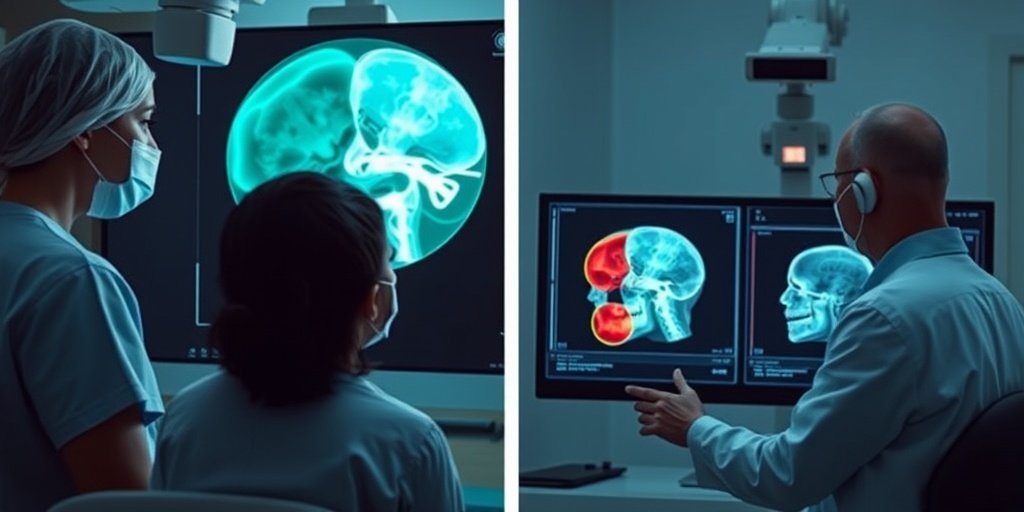⚡ Quick Summary
A recent study developed a deep learning model utilizing cross-sequence learning to effectively identify orbital fractures in radiographs of patients under 20 years old. This innovative approach demonstrated an AUROC of 0.802, significantly reducing the need for unnecessary CT scans and associated radiation exposure.
🔍 Key Details
- 📊 Dataset: 1,814 patients from two hospitals (n = 904 and n = 910)
- 🧩 Features used: Radiographs and CT scans of patients with facial trauma
- ⚙️ Technology: Deep learning model with cross-sequence learning
- 🏆 Performance: AUROC of 0.802, Sensitivity 65.8%, Specificity 86.5%
🔑 Key Takeaways
- 🩺 Orbital fractures are a medical emergency requiring urgent intervention.
- 💡 Deep learning can enhance the detection of fractures in radiographs.
- 📉 Reduced CT scans lead to lower radiation exposure for young patients.
- 📈 Model assistance significantly improved detection metrics for both ophthalmic surgeons and radiology residents.
- 🔍 Specificity improved significantly with model assistance (P < 0.001).
- 🤖 The model achieved a positive predictive value (PPV) of 70.9% and a negative predictive value (NPV) of 83.5%.
- 🌍 Study published in Front Bioeng Biotechnol, highlighting advancements in medical imaging.

📚 Background
Orbital fractures in young patients are critical conditions that often necessitate immediate surgical intervention. Traditionally, high-resolution CT scans have been the gold standard for diagnosis. However, the potential to utilize radiographs for initial assessments could significantly decrease the number of unnecessary CT scans, thereby minimizing radiation exposure, especially in pediatric populations.
🗒️ Study
This retrospective study involved the development and validation of a multi-input deep learning model designed to detect orbital fractures in radiographs. The dataset comprised patients with facial trauma who underwent both orbital rim view radiographs and CT scans. The data was meticulously divided into training, tuning, and internal test sets to ensure robust model performance.
📈 Results
The proposed model achieved an impressive AUROC of 0.802, indicating a strong ability to distinguish between fractured and non-fractured cases. The sensitivity was recorded at 65.8%, while specificity reached 86.5%. Notably, the model’s assistance led to statistically significant improvements in detection metrics for both the ophthalmic surgeon and the radiology resident, particularly in terms of specificity.
🌍 Impact and Implications
The findings from this study could have profound implications for the management of orbital fractures in young patients. By integrating advanced deep learning techniques into clinical practice, healthcare providers can enhance diagnostic accuracy while reducing unnecessary radiation exposure. This approach not only streamlines patient care but also promotes safer practices in pediatric radiology.
🔮 Conclusion
This study highlights the transformative potential of deep learning in the field of medical imaging, particularly for detecting orbital fractures in young patients. The ability to accurately identify fractures using radiographs could lead to significant advancements in patient management and safety. Continued research in this area is essential to further refine these technologies and expand their applications in healthcare.
💬 Your comments
What are your thoughts on the use of deep learning for detecting orbital fractures? We would love to hear your insights! 💬 Share your comments below or connect with us on social media:
Deep learning model using cross-sequence learning to identify orbital fractures in radiographs of patients under 20 Years.
Abstract
Orbit fractures under 20 years are a medical emergency requiring urgent surgery with the gold standard modality being high-resolution CT. If radiography could be used to identify patients without fractures, the number of unnecessary CT scans could be reduced. The purpose of this study was to develop and validate a deep learning-based multi-input model with a novel cross-sequence learning method, which outperforms the conventional single-input models, to detect orbital fractures on radiographs of young patients. Development datasets for this retrospective study were acquired from two hospitals (n = 904 and n = 910). The datasets included patients with facial trauma who underwent orbital rim view and CT. The development dataset was split into training, tuning, and internal test sets in 7:1:2 ratios. A radiology resident, pediatric radiologist, and ophthalmic surgeon participated in a two-session observer study examining an internal test set, with or without model assistance. The area under the receiver operating characteristic curve (AUROC), sensitivity, specificity, positive predictive value (PPV), negative predictive value (NPV), and 95% confidence intervals (CIs) were obtained. Our proposed model detected orbital fractures with an AUROC of 0.802. The sensitivity, specificity, PPV, and NPV of the model achieved 65.8, 86.5, 70.9, and 83.5%, respectively. With model assistance, all values for orbital fracture detection improved for the ophthalmic surgeon, with a statistically significant difference in specificity (P < 0.001). For the radiology resident, specificity exhibited significant improvement with model assistance (P < 0.001). Our proposed model was able to identify orbital fractures on radiographs, reducing unnecessary CT scans and radiation exposure.
Author: [‘Kim J’, ‘Lee S’, ‘Ahn SM’, ‘Choi G’, ‘Je BK’, ‘Park BJ’, ‘Cho Y’, ‘Oh S’]
Journal: Front Bioeng Biotechnol
Citation: Kim J, et al. Deep learning model using cross-sequence learning to identify orbital fractures in radiographs of patients under 20 Years. Deep learning model using cross-sequence learning to identify orbital fractures in radiographs of patients under 20 Years. 2025; 13:1613417. doi: 10.3389/fbioe.2025.1613417